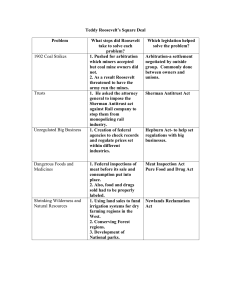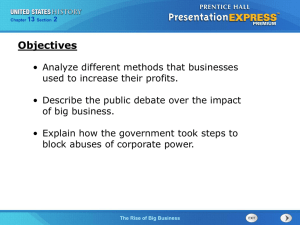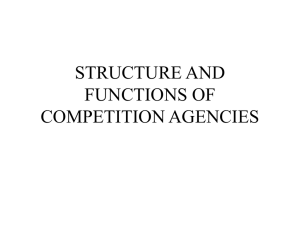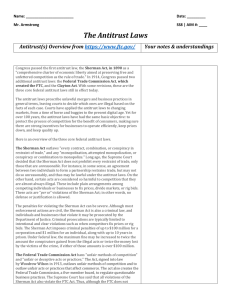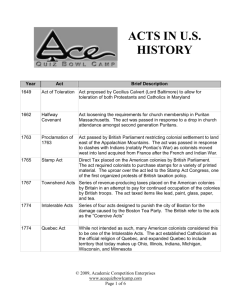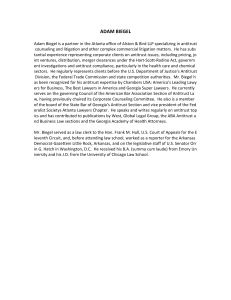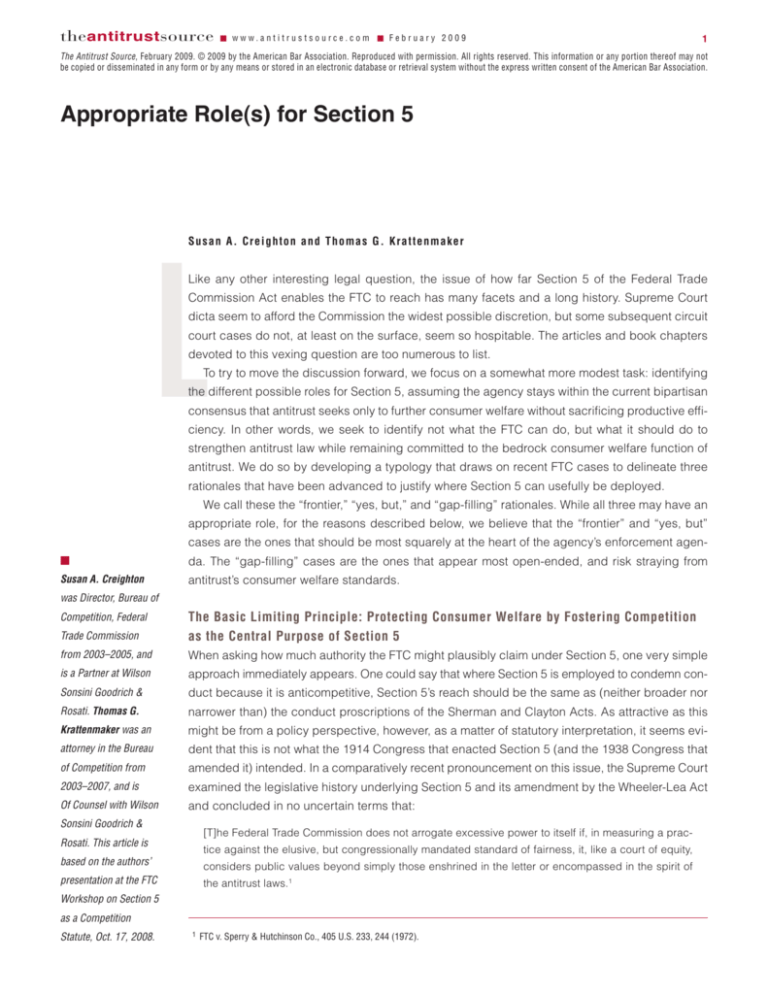
the antitrust source
䡵 www.antitrustsource.com
䡵 February 2009
1
The Antitrust Source, February 2009. © 2009 by the American Bar Association. Reproduced with permission. All rights reserved. This information or any portion thereof may not
be copied or disseminated in any form or by any means or stored in an electronic database or retrieval system without the express written consent of the American Bar Association.
Appropriate Role(s) for Section 5
S u s a n A . C r e i g h t o n a n d Thomas G. Krattenmaker
L
Like any other interesting legal question, the issue of how far Section 5 of the Federal Trade
Commission Act enables the FTC to reach has many facets and a long history. Supreme Court
dicta seem to afford the Commission the widest possible discretion, but some subsequent circuit
court cases do not, at least on the surface, seem so hospitable. The articles and book chapters
devoted to this vexing question are too numerous to list.
To try to move the discussion forward, we focus on a somewhat more modest task: identifying
the different possible roles for Section 5, assuming the agency stays within the current bipartisan
consensus that antitrust seeks only to further consumer welfare without sacrificing productive efficiency. In other words, we seek to identify not what the FTC can do, but what it should do to
strengthen antitrust law while remaining committed to the bedrock consumer welfare function of
antitrust. We do so by developing a typology that draws on recent FTC cases to delineate three
rationales that have been advanced to justify where Section 5 can usefully be deployed.
We call these the “frontier,” “yes, but,” and “gap-filling” rationales. While all three may have an
appropriate role, for the reasons described below, we believe that the “frontier” and “yes, but”
cases are the ones that should be most squarely at the heart of the agency’s enforcement agen-
䡵
da. The “gap-filling” cases are the ones that appear most open-ended, and risk straying from
Susan A. Creighton
antitrust’s consumer welfare standards.
was Director, Bureau of
Trade Commission
The Basic Limiting Principle: Protecting Consumer Welfare by Fostering Competition
as the Central Purpose of Section 5
from 2003–2005, and
When asking how much authority the FTC might plausibly claim under Section 5, one very simple
is a Partner at Wilson
approach immediately appears. One could say that where Section 5 is employed to condemn con-
Sonsini Goodrich &
duct because it is anticompetitive, Section 5’s reach should be the same as (neither broader nor
Rosati. Thomas G.
narrower than) the conduct proscriptions of the Sherman and Clayton Acts. As attractive as this
Krattenmaker was an
might be from a policy perspective, however, as a matter of statutory interpretation, it seems evi-
attorney in the Bureau
dent that this is not what the 1914 Congress that enacted Section 5 (and the 1938 Congress that
of Competition from
amended it) intended. In a comparatively recent pronouncement on this issue, the Supreme Court
2003–2007, and is
examined the legislative history underlying Section 5 and its amendment by the Wheeler-Lea Act
Of Counsel with Wilson
and concluded in no uncertain terms that:
Competition, Federal
Sonsini Goodrich &
[T]he Federal Trade Commission does not arrogate excessive power to itself if, in measuring a pracRosati. This article is
tice against the elusive, but congressionally mandated standard of fairness, it, like a court of equity,
based on the authors’
considers public values beyond simply those enshrined in the letter or encompassed in the spirit of
presentation at the FTC
the antitrust laws.1
Workshop on Section 5
as a Competition
Statute, Oct. 17, 2008.
1
FTC v. Sperry & Hutchinson Co., 405 U.S. 233, 244 (1972).
the antitrust source
䡵 www.antitrustsource.com
䡵 February 2009
2
Nothing the Court has written since calls that expansive view into question.
Even if the FTC can reach conduct not otherwise proscribed by other antitrust laws, the question remains, should it? And, if so, why?
As an initial limiting principle, we would argue that in its implementation of Section 5, the FTC
should leave fully intact the current bipartisan antitrust consensus that antitrust is designed to protect competition, not competitors; that it protects against the use of market power, not efficient
conduct; and that it seeks to prevent diminution of consumer welfare, and to do no more than that.
This consensus is embodied in such otherwise disparate key decisions and documents as the
Supreme Court’s decision in Leegin, 2 the D.C. Circuit’s Microsoft decision, 3 the agencies’
Horizontal Merger Guidelines,4 and the Commission’s opinion, affirmed by the D.C. Circuit, in
Three Tenors.5 Section 5 should not, we submit, be allowed to impose antitrust liability for conduct
Reviewing judges are
that does not threaten these fundamental principles of antitrust. The latitude that Congress built
into Section 5 should not be used to sacrifice efficient behavior for insignificant or illusory increas-
not necessarily
es in consumer welfare or to shield competitors from the rigors of efficient competition.
disregarding the
lenge to it. If, in performing its competition-protecting mission, the agency should be sacrificing
Because this is, so far as we can tell, a consensus position, we know of no current forceful chalefficiency or consumer welfare for other goals, we do not know what those goals are or why
Supreme Court’s dicta
Section 5 is an appropriate means to pursue them.
concerning Section 5
as a matter of competition policy, but appears to be an inescapable requirement of the trilogy of
Treating the consumer welfare goal as the central limiting principle seems to us not only right
cases, decided in the 1980s, that rejected somewhat more extravagant views of Section 5.6
when they hold the
Reviewing judges are not necessarily disregarding the Supreme Court’s dicta concerning Section
Commission’s feet to
petition cases—that is, they must rest on proof of probable actual competitive effects, measured
5 when they hold the Commission’s feet to the fire by requiring that competition cases be comby the consumer welfare standard. So, even if the Commission wanted to extend Section 5 to
the fire by requiring
reach conduct not within the ambit of current antitrust policy, we doubt that reviewing courts would
permit this, notwithstanding some of the more elastic phrases in cases like Sperry & Hutchinson.7
that competition
Role(s) for Section 5: A Legal Tool to Reach Anticompetitive Effects
cases be competition
Where, then, should Section 5 come into play in the antitrust enforcer’s approach? As an initial
screen we would ask: Does the conduct at issue have the same effect, from an economic com-
cases . . .
petition policy perspective, as the types of conduct that are subject to liability under the Sherman
Act? If the economic effect of the conduct is the same, the presumption is that the case ought to
be brought under the Sherman Act.
Therefore, the second step of the inquiry is to ask: Is there nonetheless some legal reason to
bring the challenge under Section 5 rather than the Sherman Act? Drawing on cases filed by the
2
Leegin Creative Leather Prods., Inc. v. PSKS, Inc., 127 S. Ct. 2705 (2007).
3
United States v. Microsoft Corp., 253 F.3d 34 (D.C. Cir. 2001) (en banc).
4
U.S. Dep’t of Justice & Federal Trade Comm’n, Horizontal Merger Guidelines (1992, revised 1997), available at http://www.ftc.gov/bc/docs/
5
PolyGram Holding, Inc., FTC Docket No. 9298, 2003 WL 21770765, available at http://www.ftc.gov/os/2003/07/polygramopinion.pdf, aff’d,
horizmer.htm.
PolyGram Holdings, Inc. v. FTC, 416 F.3d 29 (D.C. Cir. 2005).
6
See Official Airline Guides, Inc. v. FTC, 630 F.2d 920 (2d Cir. 1980); Boise Cascade Corp. v. FTC, 637 F.2d 573 (9th Cir. 1980); E.I. du Pont
de Nemours & Co. v. FTC, 729 F.2d 128 (2d Cir. 1984) (Ethyl ).
7
FTC v. Sperry & Hutchinson Co., 405 U.S. 233 (1972).
the antitrust source
䡵 www.antitrustsource.com
䡵 February 2009
3
FTC during the past several years, we have identified three different rationales that might be used
to justify bringing a case under Section 5. We call them the “frontier,” “yes, but,” and “gap-filling”
rationales.
The “frontier” rationale argues that there are some cases that meet all of the legal requirements
for a Sherman Act claim, but involve new forms of anticompetitive conduct that fall outside traditional categories of conduct that have long been subjected to conventional antitrust analysis.
Former FTC Commissioner Tom Leary has made strong arguments for the application of Section
5 in this context.8 The “yes, but” argument comes into play when a case would meet all the economic and legal requirements of a Sherman Act claim, but cannot be brought under the Sherman
Act because of legal limitations imposed for reasons unrelated to the goals of antitrust law. The
application of Section 5 in these circumstances is grounded in the notion that the concerns that
Depending on the facts,
led to these legal limitations in the Sherman Act (principally the concern regarding private trebledamage actions) cannot justify shielding otherwise anticompetitive conduct from FTC scrutiny.
Finally, the “gap-filling” rationale might be invoked if a case would satisfy the economic require-
each of these different
ments of antitrust, but fails one of the legal elements of Section 1 (such as the “agreement”
potential rationales
requirement) or Section 2 (such as the “monopoly power” element).
Depending on the facts, each of these different potential rationales for the invocation of Section
for the invocation of
5 might have been used to justify an enforcement action brought by the FTC during the past sev-
Section 5 might have
area. Former Commissioner Leary has noted that because Rambus 9 involved a type of conduct
eral years. Consider, for example, an action challenging unilateral conduct in the standard-setting
that has only recently received careful antitrust scrutiny, the FTC might better have brought the
been used to justify an
case exclusively under Section 5—a “frontier” rationale. On the other hand, in Unocal,10 another
case involving standard setting, a “yes, but” rationale might have been considered in deciding
enforcement action
whether to invoke a stand-alone Section 5 action because Noerr was an important defense asserted in that case. Finally, N-Data 11 appears to have been supported by the majority under a “gap-
brought by the FTC
filling” rationale, inasmuch as the Commissioners in the majority acknowledged that the facts in
that case did not support a claim under the Sherman Act.
In our view, the “frontier” and “yes, but” cases seem to be the safest and most compelling appli-
during the past
cations of a separate Section 5, at least so long as these rationales are not used to skip over a
several years.
rigorous analysis of whether the legal elements of a Sherman Act claim otherwise are met. The
“gap-filling” cases may provide the greatest potential for mischief, if the scope of such cases is
not narrowly and rigorously circumscribed. One of the matters to which the Commission and its
critics may want to give more considered attention are the legal limits that should be imposed on
Section 5 in these “gap-filling” circumstances if important elements such as an “agreement” or
“monopoly power” are not present.
In the balance of this article, we discuss some additional examples of each type of case that
we have identified.
8
Thomas B. Leary, A Suggestion for the Revival of Section 5, A NTITRUST S OURCE , Feb. 2009, http://www.abanet.org/antitrust/
9
Rambus, Inc. v. FTC, 522 F.3d 456 (D.C. Cir. 2008).
at-source/09/02/Feb09-Leary2-26f.pdf.
10
Union Oil Co. of Cal., FTC Docket No. 9305, Opinion of the Commission (July 7, 2004) (rejecting Noerr defense and remanding for trial),
available at http://www.ftc.gov/os/adjpro/d9305/040706commissionopinion.pdf.
11
Negotiated Data Solutions LLC, FTC File No. 51-0094 (Sept. 23, 2008) (complaint), available at http://www.ftc.gov/os/caselist/0510094/
080923ndscomplaint.pdf.
the antitrust source
䡵 www.antitrustsource.com
䡵 February 2009
4
1. Frontier Cases. Perhaps the least controversial application of a stand-alone Section 5 claim
should be its use in “frontier” settings, where Section 5 could provide an avenue for redressing
anticompetitive acts or practices that have newly emerged and have not yet been fully absorbed
into the fabric of the Sherman or Clayton acts. Whether it be the elaborate information dissemination schemes of the 1920s 12 or the unwarranted Orange Book listings of the 1990s,13 we know
from experience that new forms of anticompetitive behavior will arise from time to time. It would
appear to be a clear opportunity to take advantage of the FTC’s experience as an expert body to
bring its analytic resources to bear on such new forms of anticompetitive behavior.
Because courts may be reluctant to impose liability where behavior is new and unfamiliar,
Section 5 may have advantages in these “frontier” cases due to its prospective application and
lack of provision for private damages recovery (much less treble damages or class actions).
Former Commissioner Leary gives Schering 14 and Rambus as examples of cases that might
have been better brought exclusively under Section 5 because “the Commission was primarily
interested in establishing some ground rules applicable to settlement of patent disputes between
pioneer and generic drug manufacturers (Schering), and to the conduct of companies who participate in standard-setting bodies (Rambus).”15
Another example of a case that might have been a good candidate for “frontier” status, had it
been handled by the FTC, was United States v. AT&T,16 the case that led to the break-up of the
U.S. telephone monopoly. AT&T was essentially two cases, one challenging monopolization of
long distance service and the other claiming monopoly over telecommunications equipment.
Both were well grounded in the economic policy underlying the Sherman Act, but each rested on
asserted behavior—discriminatory interconnection in the long distance phase of the case, predatory cross-subsidization in the equipment phase—for which clear Sherman Act precedent was
lacking.17 Because the case settled before verdict, we will never know if the courts would have
balked at reading the Sherman Act to cover the challenged conduct, but surely judicial reluctance
was a risk. An action under Section 5 would have been particularly appropriate given that the government’s goal was to obtain structural relief, not to punish the defendant, deter similar acts, or
clear the way for private treble damage actions.
Perhaps the principal risk from a stand-alone Section 5 action in this context is that, precisely
because the conduct is new, the “frontier” rationale might too easily become a means for the
Commission to short-circuit asking the hard analytical questions imposed by the rigorous standards of the Sherman Act—questions that become all the more important when considering new
forms of conduct. There is also the risk that, by bringing the case exclusively under Section 5, the
Commission ironically might weaken its influence as an expert voice in the antitrust debate regarding the proper application of the Sherman Act.
To guard against these tendencies, the Commission in “frontier” cases would need to analyze
and litigate the case precisely as it would under the Sherman Act, with the only exception being
12
See, e.g., Am. Column & Lumber Co. v. United States, 257 U.S. 377 (1921); Maple Flooring Mfrs. Ass’n v. United States, 268 U.S. 563
(1925).
13
See In re Buspirone Patent Antitrust Litig., 185 F. Supp. 2d 363 (S.D.N.Y. 2002).
14
Schering-Plough v. FTC, 402 F.3d 1056 (11th Cir. 2005).
15
Leary, supra note 7, at 3.
16
See United States v. AT&T, 552 F. Supp. 131 (D.D.C. 1982), aff’d, 460 U.S. 1001 (1983) (ruling on consent decree).
17
For a comprehensive description of the antitrust theories underlying the government’s case in United States v. AT&T, see T HOMAS G.
K RATTENMAKER , T ELECOMMUNICATIONS L AW & P OLICY 376-410 (2d ed. 1998).
the antitrust source
䡵 www.antitrustsource.com
䡵 February 2009
5
that it would explicitly limit the relief sought because of the novelty of the challenged conduct.
Otherwise the Commission might find that even if it is more likely to “win” a pure Section 5 claim,
it might come at the cost of having failed to develop a broader consensus that the conduct is anticompetitive and precisely why it deserves condemnation.
2. “Yes, But” Cases. A different group of cases that might warrant challenge under Section 5 are
what might be called the “yes, but” cases. These are cases where, strictly on the antitrust merits
and the terms of the antitrust statutes, the conduct would be condemned, but legal concerns
extrinsic to the antitrust statutes cause courts to pull back from recognizing a Sherman Act claim.
Like the “gap filling” cases, they address anticompetitive conduct that escapes Sherman Act condemnation because of a legal shortcoming. The “yes, but” cases, however, involve legal constraints imposed for reasons having nothing to do with antitrust law or policy. Indeed, for some of
these cases, Section 5 might sensibly permit the Commission to take advantage of unique aspects
of Section 5—particularly its deliberate limitations to prospective relief only, and then only in
cases brought by a federal expert agency—to reach conduct that, but for the invocation of nonantitrust policy considerations, would be condemned as anticompetitive and harmful to consumer welfare. Drawing on recent history, here are some potential examples:
Anticompetitive Conduct Protected by Antitrust Immunities. The FTC has devoted considerable
resources to seeking to restrict the growing scope of doctrines such as Noerr,18 which is a classic “yes, but” defense: the conduct is anticompetitive, but non-antitrust concerns are invoked to
shield it from Sherman Act scrutiny. Given the substantial differences between the Sherman Act
and Section 5, however, might it not be the case that some of the anticompetitive conduct protected by Noerr against Sherman Act liability might nonetheless be subject to limited prospective
relief under Section 5?
The Noerr doctrine is neither an antitrust principle19 nor a rule of constitutional law.20 Noerr is a
principle of statutory interpretation, and at least some of the concerns that apparently drove the
Noerr Court are not applicable to Section 5. For example, to the extent that the Noerr doctrine is
driven by the fear that antitrust liability will “chill” protected speech, Section 5 cases—limited to
prospective cease and desist remedies and in cases filed only by an expert impartial government
agency—should prove much less chilling than Sherman Act litigation.
The FTC challenged conduct allegedly protected by Noerr in the Orange Book listing cases.
Although the Commission prevailed in these cases on straightforward Sherman Act grounds,21 the
FTC might well have brought these cases under Section 5. For another example, several courts
have held that threats to litigate can be shielded from antitrust proscription by Noerr,22 and some
litigants have even argued that settlements might be Noerr-protected.23 But there can be little question that litigation threats and settlements can, under the wrong circumstances, cause material anticompetitive injury without yielding any efficiency benefit. Such acts are not, in any way, shape, or
form constitutionally protected petitioning conduct. Whatever the merits of seeking to protect such
18
Eastern RR. Presidents’ Conf. v. Noerr Motor Freight, Inc., 365 U.S. 127 (1961).
19
One of its most recent applications was to the National Labor Relations Act. See BE & K Construction Co. v. NLRB, 536 U.S. 516 (2002).
20
We know of no one who has ever suggested that all conduct immunized by Noerr was already independently shielded from antitrust
scrutiny by the First Amendment.
21
See e.g., In re Buspirone Patent Antitrust Litig., 185 F. Supp. 2d 363 (S.D.N.Y. 2002).
22
See, e.g., Coastal States Mktg., Inc. v. Hunt, 694 F.2d 1358 (5th Cir. 1983).
23
See, e.g., Andrx Pharms. v. Biovail Corp. Int’l, 256 F.3d 799 (D.C. Cir. 2001) (rejecting argument that terms of patent litigation settlement
were immune from antitrust scrutiny under Noerr).
the antitrust source
䡵 www.antitrustsource.com
䡵 February 2009
6
conduct from the chill of private enforcement, would the FTC not be on firm ground in ordering a
firm to cease and desist from threats to litigate if those threats produce only anticompetitive consequences or from settlement of litigation that merely creates, and then distributes the rewards
from, market power? Particularly where the anticompetitive consequences are clear, the lack of any
justification is evident, and the risk of unlimited liability is avoided, it seems to us that challenging
anticompetitive conduct protected by Noerr—but not the First Amendment—could be a salutary
use for Section 5.
Similarly, the state action doctrine 24 reflects the very sound principle that the antitrust laws
should not be read to impose on the states the laissez-faire regime of Lochner v. New York.25 If
states want to displace competition and actively supervise the resulting regulated markets, then
the Sherman Act will not be read to forbid that, just as the demise of Lochner means that the due
process clause no longer stands as a barrier to states opting for regulation over competition.
Again, however, we wonder whether Section 5 must have a reach in this area that is precisely coterminous with that of Section 1. For example, what about the state supervision that is in practice—
for want of a better word—a sham? In truth, this is what the FTC confronted in the Kentucky
Movers case.26 What if the Commission examined the application, on very specific facts and on a
case-by-case basis, of states’ certificate of need statutes? 27 Why could the FTC not be permitted
to void a specific application of such a statute in order to protect against what turned out to be,
upon inspection, nothing more than a raw extension of market power? Particularly where the remedy is a simple cease and desist order, such a case seems to us potentially compelling. Further,
providing the FTC—and only the FTC—with authority to examine with greater care the justification
for a state’s decision to displace competition as a disciplinary force, and the effects on consumer
welfare of that displacement, should avoid fears of permitting anyone aggrieved by a regulatory
regime anywhere in the economy to challenge that regime as a violation of the Sherman Act.
We are not experts with regard to non-judicially created statutory antitrust immunities. When
enforcing the antitrust laws, if one encounters an immunity, one just moves on. Nevertheless, we
do think it might be worthwhile to examine a series of statutory immunities or exemptions to see
if they were enacted, for example, because of a fear that private, treble damages actions, perhaps
including class actions, would be particularly harmful to that industry. If such an exemption is discovered and if the immunity does not expressly extend to the FTC Act, it might constitute a
responsible and modest use of Section 5 to put these otherwise shielded practices under the
antitrust microscope for the limited purposes of FTC investigation and potential cease and desist
remedies.
Patents/Antitrust Interface. The edges where patent law and antitrust law interface are not
smooth. The Sherman Act has proven not fully capable of responding to certain challenges stemming from behavior with patents that threatens consumer welfare. One obvious example: as
presently construed, the Walker Process 28 doctrine seems to have a gaping legal hole. Most
24
The state action doctrine is extensively reviewed and critiqued in the FTC’s Report of the State Action Task Force (Sept. 2003), available at
http://www.ftc.gov/os/2003/09/stateactionreport.pdf.
25
26
198 U.S. 45 (1905).
Ky. Household Goods Carriers Ass’n, FTC Docket No. 9309 (June 2005), available at http://www.ftc.gov/os/adjpro/d9309/050622opinionof
thecommission.pdf.
27
By “certificate of need statutes” we refer to state laws that restrict entry into certain professions, markets, or industries to those who can
first convince the state authorities that there is a need for additional competition.
28
Walker Process Equip., Inc. v. Food Mach. & Chem. Corp., 382 U.S. 172 (1965).
the antitrust source
䡵 www.antitrustsource.com
䡵 February 2009
7
courts read Walker Process to require that the antitrust plaintiff prove not only that the patent was
procured by fraud on the patent office, but also that the patent was “enforced,” in addition to the
conventional Sherman Act elements.29
An “enforcement” requirement must find its justification in some law other than antitrust. If
“enforced” means that a lawsuit alleging infringement must have been filed, then antitrust law
leaves unremedied the threat of suit, directed at an alleged infringer or (often with even more serious consequences) the customers of the alleged infringer, even though the simple threat can
have, under the wrong circumstances, very serious anticompetitive consequences. The Federal
Circuit realized this problem in the Hydril case.30 Under a “yes, but” rationale, Section 5 might be
an appropriate vehicle to inquire into allegations of anticompetitive misuse of patents by means
other than enforcement. Nor need such cases be confined solely to patents procured by fraud.
Deceptive threats to sue for infringement can—where other conditions are present—have inefficient, anticompetitive consequences even if there are arguably valid patents underlying the threat.
Although we cannot prove it, we suspect that some of the limitations on antitrust enforcement
in the patent area, such as those just mentioned, stem from the fear of unbridled liability for what
could, on the surface, appear to be simply the exercise of a statutory right. To the extent that this
is so, Section 5, precisely because it does not provide for unbounded liability, becomes a potentially more attractive tool for challenging inefficient anticompetitive cost-raising behavior where it
occurs.
Cheap Exclusion. We have argued elsewhere that combating what we called cheap exclusion
should be high on the list of enforcement priorities for the FTC’s Bureau of Competition.31
Exclusionary practices that are both inexpensive to undertake and incapable of yielding any
cost-reducing efficiencies are “cheap” in both senses of that term and are most likely to appeal
to any firm bent on acquiring market power by anticompetitive means. Section 5 could be a significant tool in preventing cheap exclusion, although most forms of cheap exclusion can and
should be reached via straightforward application of the Sherman Act.
A common objection to antitrust enforcement against some types of cheap exclusion is that it
might “make a federal treble damages case out of a common law tort.” As we have noted elsewhere,32 we do not agree with a legal principle that conduct should be immunized because it is
already illegal under another legal principle. Nonetheless, to the extent that concerns about private enforcement under the Sherman Act could threaten to turn many state torts into a federal treble-damages claim, Section 5 might provide the obvious means for proscribing conduct that, while
tortious under conventional state law, can at the same time create very substantial competitive
harm. In such a case, Section 5 would be performing a “yes, but” role, overcoming a legal obstacle placed in the path of Sherman Act enforcement that is unrelated to antitrust law or policy.
3. Gap Filling Cases. Unlike “frontier” cases, where the conduct is novel but otherwise satisfies traditional Sherman Act requirements, and “yes, but” cases, where the elements of the
Sherman Act would be met but for the invocation of some limiting rationale unrelated to antitrust,
“gap filling” cases are ones where the conduct at issue does not (or arguably does not) meet one
29
The cases dealing with this issue are collected and neatly summarized in Christopher R. Leslie, New Possibilities for Asserting Walker
Process Claims, A NTITRUST , Summer 2007, at 48.
30
Hydril v. Grant Prideco, 474 F.3d 1344 (Fed. Cir. 2007).
31
Susan A. Creighton, D. Bruce Hoffman, Thomas G. Krattenmaker & Ernest A. Nagata, Cheap Exclusion, 72 A NTITRUST L.J. 975 (2005).
32
Id. at 993–94.
the antitrust source
䡵 www.antitrustsource.com
䡵 February 2009
8
of the elements of the Sherman Act. Most such cases likely raise questions regarding the “agreement” element of Section 1, or the “monopoly power” element of Section 2.
Perhaps the paradigmatic example of a “gap filling” case is an invitation to collude, such as the
FTC’s consent order in Valassis.33 As alleged in the complaint, that case—which was settled without trial—involved an alleged invitation to collude in a market that constituted a durable duopoly
with high barriers to entry. Invitations to collude do not fit easily within the language of either
Section 1 (where is the agreement?) or Section 2 (where is the dangerous probability of success?),
yet there is little doubt that attempted collusion is conduct that fits comfortably within the ambit of
antitrust economic and policy analysis. The conduct, if consummated, would be illegal per se,
and, even unaccepted, it may facilitate coordinated interaction by disclosing the solicitor’s preferences. Meanwhile a simple, naked invitation to collude serves no procompetitive, efficiencyenhancing purpose.
Although the Valassis case was not controversial, the risk of an unbounded application of
Section 5 is greatest in these “gap-filling” cases, and the Commission should give careful thought
to the imposition of stringent requirements where “gap-filling” is the rationale for the stand-alone
use of Section 5. We limit ourselves here to two further fact patterns where these issues may arise.
First, certain kinds of behavior may facilitate oligopolistic price stickiness, without generating
any potential cost-saving efficiencies, yet still leave unmet the Sherman Act requirement for an
agreement or concerted action. For example, consider refusals to quote other than delivered
prices in the absence of any reason to explain why delivered pricing reduces transaction costs,
or contractually committing with all buyers to announce publicly any price increase before the
price increase goes into effect without any explanation as to why, in this industry, this practice
might increase price competition. Under certain conditions, these practices—if followed by most
firms in the market—can have serious anticompetitive consequences, even if there is no evidence
of agreement on these terms among competing sellers. It would appear consistent with the policies underlying the Sherman Act to analyze such conduct under Section 5, although that raises
the question of what limits should be imposed if Section 5 were to be used in this way.34
Another potential candidate for “gap filling” adjudication under Section 5 would be what is often
referred to as “patent fishing.” When firms acquire patents and then demand payments from probable non-infringers, but where the payments are much less than the costs of litigation, this behavior—especially where repeated many times—can significantly raise the costs of the producing
firms. These increased costs are inefficiencies and will also likely yield higher prices and a diminution in consumer surplus. Depending on how the cost increases are spread, the fishing may also
create entry barriers and give some firms market power. Yet, because the patent fisher does not
itself gain from the market power that its fishing can create (or because the practice may reduce
consumer welfare but without yielding monopoly profits to any market participant), it is not obvious that conventional antitrust would speak to this behavior. Section 5 might be an appropriate tool
for investigating allegations of such conduct, but before filing such a complaint it is important to
identify the elements that must be satisfied to bound this application of the statute.
33
Valassis Commc’ns, Inc., FTC File No. 51-0008 (Mar. 14, 2006) (decision and order), available at http://www.ftc.gov/os/caselist/
0510008/060314do0510008.pdf.
34
The Ethyl case, supra note 6, might well have been another well-grounded gap filling case, given the panoply of interlocking facilitating practices at issue. However, the trial record apparently was insufficient to convince the reviewing court that actual anticompetitive effects
stemmed from the challenged conduct and the Commission was unable to persuade the court that the practices at issue lacked redeeming
procompetitive value. Consequently, on the facts as found, Ethyl would not appear to be a candidate for a Section 5 “gap filling” case.
the antitrust source
䡵 www.antitrustsource.com
䡵 February 2009
9
A Cautionary Conclusion
Although we have suggested a typology for evaluating whether particular conduct might be worthy of scrutiny under Section 5, we must emphasize that we are, of course, only speaking of proscribing behavior that is shown, after trial, to have serious, measurable anticompetitive consequences without promise of procompetitive benefits. Apart from per se cases, which might include
certain kinds of egregious exclusionary acts, any case that does not meet that standard should
not be brought under any antitrust regime, in our opinion. An interpretation of Section 5 that
crossed this line would cause harm to our economy.
Finally, although we do believe that Section 5, enforced by the expert FTC, is in fact a good
vehicle for what Congress intended—to define and proscribe forms of anticompetitive conduct,
even if they are hard to analyze under existing Sherman Act precedents—the Commission should
be exceedingly cautious in resisting the temptation to use Section 5 simply because, as a matter
of statutory authorization, it thinks it can. 䢇

